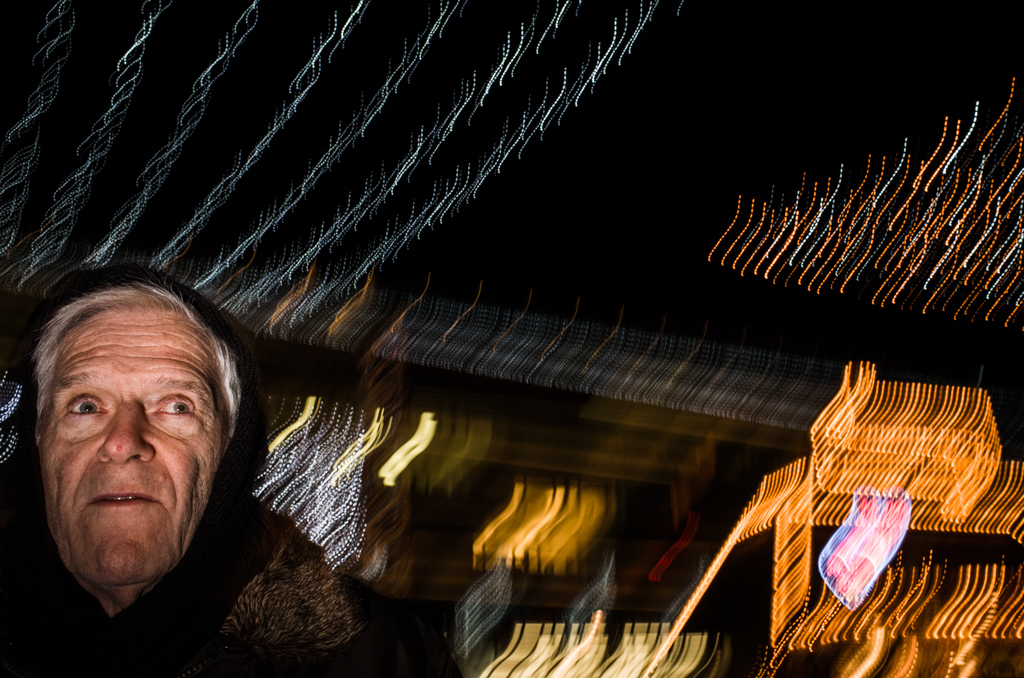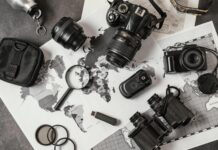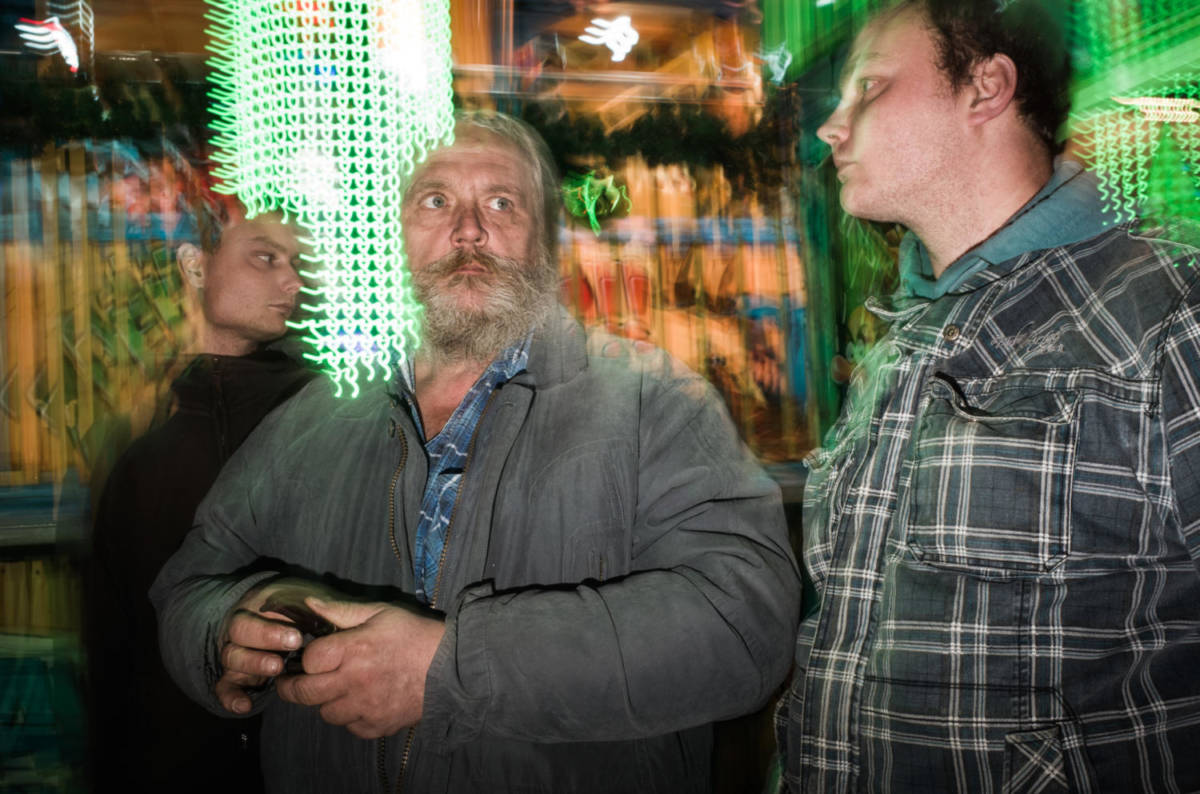Blending in is one of the most important traits of a good Street Photographer and shooting from the hip is a great technique. Acting invisibly on the street allows us to capture those candid momentscapture those candid moments without changing the scene with our own present. In case you are shooting with a big DSLR this alone might be enough to not go unnoticed. Using the viewfinder might raise too much attention because you are in an area where seldom a photographer gets lost or people might be suspicious towards a stranger. Shooting from the hip in photography might allow you to work like a stealth ninja and get really close, but the conscious composition is harder to perform when not seeing the final frame.
Shooting from The Hip in Photography
Lens Types
Using a zoom lens while shooting from the hip in photography doesn’t make a lot of sense. Without being able to control the picture through your viewfinder, using a zoom lens becomes too much of a guessing game. Even if you don’t actively use the zoom and keep it steady, there is still the chance that you will accidentally move it and change the focal length. Therefore I wouldn’t recommend using a zoom lens at all.
Instead, a fixed type of focal length works much better for this technique. Fixed focal length lenses have the benefit that you exactly know the picture frame you are getting. In addition, wide angle lenses are easier to handle than focal length longer than ~50mm. The longer the lens, the more accurate you need to work and less predictable will be the outcome. Imagine a Wildlife photographer capturing a bird mid-flight with a 600mm lens. It will become near impossible and even in Street Photography shooting blindly with an 85mm lens is a very hard exercise.
Working with 28mm gives you a wider field of view that you can work with. On the flip side, you need to get closer than with a telelens, but this is exactly why we are trying to shoot from the hip in photography.
Focusing while shooting from the hip
Without looking through the viewfinder you might be 100% dependable on the auto-focus to function properly. While the current auto-focus systems on modern cameras already work pretty decently, they are nowhere near reliable in a way that you can shoot “blindly” and don’t have a lot of out-of-focus shots on your card. Especially in low-light situations, the electronic helper will reach their limit.
Manually focusing is also near impossible. Maybe with years of training, you might be able to guess the distance right and adjust your lens accordingly. The characteristic of Street Photography where you have to act in the matter of milliseconds doesn’t allow to smoothly operate the focus ring. In addition to that difficult handling, trying to manually focus kind of destroys the idea of shooting from the hip in street photography and being inconspicuous.
The keyword for properly sharp pictures is pre-focussing. Instead of focusing manually for every picture, you set your focus beforehand to a certain distance and try to shoot from the same distance for every image. This technique has been widely used by many Street Photographers that use film cameras. For example, Bruce Gilden has set his range to about 1 1/2 meter, jokingly because at that distance he is more than one arm length away from the subject.
To understand the advantage of pre-focussing we have to talk about the technical terms of depth of field, focal length and aperture first.
The depth of field (DoF) describes the area that will be sharp in your picture. Depending on the two other influential factors of focal length and aperture, you can narrow down your depth of field or widen it.
Without becoming too specific, a shorter focal length will widen your depth of field, as well as a far open aperture. Hence the shorter your lense and the more you open your aperture, the less area will be sharp in your final picture.
For a better understanding, you can use this DoF tool: dofmaster.com
My Settings using the RicohGR
Focal length: 18mm
F-Stop: 1/8
Subject Distance: 100 cm
Total DoF: ~30cm
Far Limit: 117 cm
This means that with a pre-focussing distance of 1 meter and setting my camera to f 1/8 everything from 87 cm to 117 cm is sharp. The range is very common for shooting from the hip in photography and very suitable.
In reality, I would extend the acceptable sharpness to a few meters. So with the presented settings I try to keep a distance of roughly 50 cm to 5 meters to the subject and don’t have to worry if my camera’s auto-focus is not functioning well.
How you set the focus distance depends on your camera and lens. Using my RicohGR I am able to use the fix focus feature that allows me to set it at a certain distance. For most others camera/lens combinations you simply can set it to manual mode and leave it in the distance that is most comfortable for you.

Auto Exposure
As well as focusing might be a problem, that we now have corrected, the exposure of your shots might be challenging at first too.
Some self-described experts may find that there is no other mode than manual and that auto modes are for “amateur snapshooter” that have no idea about photography. Craftsmen choose their tools in accordance with their work. In this case, the best option we have is an auto mode.
Depending on your Street Photography camera you have different possibilities to customize your auto-modes. A lot of modern DSLRs allow you to choose an auto mode while establishing different boundaries to your settings. You might be able to use the P-mode which chooses the settings completely on its own, while you can set a minimum shutter speed and apertures. If your camera has this feature this mode fits the best for shooting from the hip in photography. As a minimum shutter speed, I recommend you to not go below 1/200th of a second. The reason behind this is, that with this shutter speed you are still able to slowly walk and take the shot, without entirely to stand still.
With our goal in mind to become a stealth ninja on the street, we should avoid anything that seems suspicious. Walking at a normal pace and then suddenly to stop down without any reason is one thing that draws attention, that we want to eliminate.
For the aperture, we need to keep a focus on the depth of field. Therefore we aren’t that variable in this area. If you like to shoot with an f-stop of 1/8, it is advisable not go below 1/5,6. Staying within a range of one f-stop doesn’t drastically reduce the depth of field and lets you shoot with your comfortable settings from the hip.
Therefore I’d recommend auto settings within the following range
Camera Settings
Shutter Speed: min 1/200th of a second
f-stop: min 1/5,6
ISO: min 100 max 1.600
Tips for Shooting from the Hips
Now that we got the technical parts covered there are enough things left we need to consider to go full undercover mode while photographing from the hip.
I already talked about the normal walking pace and not doing any unusual movements that make you look conspicuous.
No eye-Contact
While passing others pedestrian you should avoid eye contact with other persons around you. This might sound a little anti-social since we are still humans after all and even when we don’t carry our camera around it’s pretty normal to make eye contact. While trying to shoot from the hip in street photography, glancing where you are gonna shoot draws too much attention. To not look like a zombie that forcefully stares in one direction, searching for something interesting in the background and looking behind other people, works wonders.
Low-Key equipment
Anything that raises the bar from a typical tourist to a professional photographer should be avoided. Therefore big DSLRs, huge photo bags or even neck straps aren’t helpful in going undercover. Neck straps aren’t really eye-catching, but if you want to shoot from the hip in photography, you need to carry your camera casually in your hand and be able to operate it with only one hand. A wrist-strap might be more functional if you are concerned about dropping your camera.
Silent Shutter
I already praised mirrorless or point and shoot cameras for their smallness and easy usability. There is another benefit that they offer, that is a hindrance for DSLRs. Today’s mirrorless cameras either offer a silent shutter mode or are inherently more quiet than their bigger counterparts with a mirror. In an area where the shutter mode might be noticeable, using silenced tools is more useful while shooting from the hip.
Dutch Angle
The Dutch angle is a technique used mainly in movies where the camera is tilted to the left or right. A lot of Photographers already have problems to achieve a plane level, using the viewfinder. Shooting blindly obviously adds to the level of difficulty. The tilt can add to the dynamic character of the close-up shot or partially create a spacy photograph.
Series function
To capture the right moment the series mode on your camera might help you out. Without looking at the screen it can be quite hard to exactly get the decisive moment. Having the choice between a handful of photos makes it easier to get the desired result.

With Great Power Comes Great Responsibility
We successfully perfected our superpower of being able to photograph anything and anybody from a close distance without being noticed. Overcoming any social boundaries allows us to create intimate photos that wouldn’t be possible candidly any other way. This raises some moral questions that I want to make everyone aware, before hitting the street and bursting pictures shooting from the hip.
Normally I act under the caption, that I photograph openly and anyone who doesn’t share my passion for street photography is able to communicate his concerns and ask me to delete pictures of them. In my opinion, this is a fair game for both ends of the camera.
Without the opposite noticing that they are being photographed from the hip, we create an asymmetrical power that we need to take into account while being on the street or at least editing the pictures. There already are a lot of creepy photographers out there hunting with big tele lenses for young ladies. Don’t be one of them and instead look for truly creative, positive and unique photo opportunities.
Reconsider if your picture might be in any way detractory and tighten up your published pictures accordingly.
Hopefully, this useful technique might help you to overcome some initial fear of getting close and photographing. If you are struggling with the anxiety of shooting openly, trying out to shoot from the hip in photography first might show you that there is nothing to fear about.
Stay Curious
Sebastian Jacobitz






















